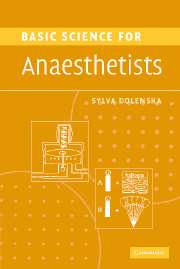Book contents
- Frontmatter
- Contents
- List of abbreviations and symbols
- List of figure captions
- Forewords
- Preface
- Preface to the second edition
- Part 1 Physics, mathematics, statistics, anaesthetic apparatus
- Part 2 Clinical measurement
- 1 Basic measurement concepts
- 2 Electromanometers, frequency response and damping
- 3 Pulse oximeter principle
- 4 Oxygen content and oxygen tension measurement
- 5 Capnography
- 6 [H+], pH and its measurement
- 7 Principles of measurement of volume and flow in gases and liquids
- 8 Cardiac output measurement by thermal dilution technique
- 9 Measurement of the mechanical properties of the chest
- 10 Lung volumes and their measurement
- Part 3a Physiology: the cardiovascular system
- Part 3b Physiology: the respiratory system
- Part 4 Pharmacology
- Further Reading
- Index
5 - Capnography
from Part 2 - Clinical measurement
Published online by Cambridge University Press: 13 August 2009
- Frontmatter
- Contents
- List of abbreviations and symbols
- List of figure captions
- Forewords
- Preface
- Preface to the second edition
- Part 1 Physics, mathematics, statistics, anaesthetic apparatus
- Part 2 Clinical measurement
- 1 Basic measurement concepts
- 2 Electromanometers, frequency response and damping
- 3 Pulse oximeter principle
- 4 Oxygen content and oxygen tension measurement
- 5 Capnography
- 6 [H+], pH and its measurement
- 7 Principles of measurement of volume and flow in gases and liquids
- 8 Cardiac output measurement by thermal dilution technique
- 9 Measurement of the mechanical properties of the chest
- 10 Lung volumes and their measurement
- Part 3a Physiology: the cardiovascular system
- Part 3b Physiology: the respiratory system
- Part 4 Pharmacology
- Further Reading
- Index
Summary
Capnography is the measurement of carbon dioxide in a gas mixture. It uses the method of infrared absorption spectrophotometry. All gases with dissmilar atoms in the molecule, such as carbon dioxide and nitrous oxide, absorb infrared light. Peak absorbance by carbon dioxide is at 4.26 μm, fairly close to, but distinguishable from, the two nitrous oxide peaks at a slightly higher wavelength. Modern capnographs therefore utilize narrow bandwidth infrared light of 4.26 μm wavelength. Figure 69 shows as schematic representation of a capnograph. After passing through the monochromatic filter and the sampling chamber, residual light is detected by an infrared light detector and processed electronically. The windows of the sampling chamber have to be made from halogen crystals or other materials that do not absorb infrared light. To avoid drift, most instruments incorporate a reference chamber and a chopper close to the source of light to provide a discontinuous source of light (not included in the diagram).
There are two types of infrared CO2 monitors: sidestream and mainstream capnographs; they differ in the gas sampling technique. Sidestream capnographs sample from the breathing system via a sampling line. The apparatus is lightweight and is suitable after adaptation for unintubated subjects. Mainstream capnographs have a measuring head placed in close proximity to the endotracheal tube, and the measuring chamber is heated to prevent condensation. These are heavy and cumbersome, are sensitive to external contamination with dirt and have the potential to cause burns and to break.
- Type
- Chapter
- Information
- Basic Science for Anaesthetists , pp. 86 - 91Publisher: Cambridge University PressPrint publication year: 2006



